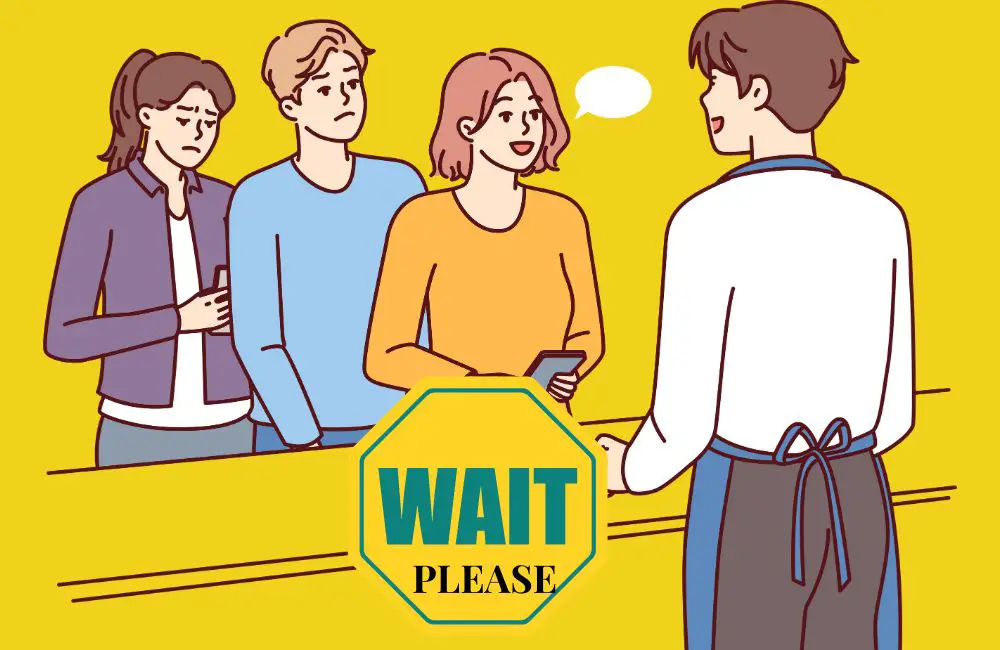Asking a customer to wait is common in any customer service job. However, how it is communicated can make all the difference in customer satisfaction. This guide will provide practical advice on how to ask a customer to wait politely in English.
When asking a customer to wait, phrases like “Could you kindly hold for a moment?” or “Can I put you on a brief hold while I check this?” convey your request politely. Providing clear wait time estimates and offering alternatives during longer waits can improve customer satisfaction.
Are you looking for a book or a guide to help you learn and improve your English? You may try English Made Easy Volume One: A New ESL Approach: Learning English Through Pictures (Amazon Link).
Continue reading the full article to understand this vital customer service skill better. You’ll discover a wealth of information, detailed strategies, and a plethora of practical examples.
Table of Contents
- General English Expressions to Politely Ask a Customer to Wait
- Asking a Customer to Wait in English in Specific Contexts
- Effective Strategies for Asking a Customer to Wait
- Sample Conversation: Politely Asking a Customer to Wait in English
- In Conclusion
- 10 Frequently Asked Questions Related to Politely Asking a Customer to Wait in English
General English Expressions to Politely Ask a Customer to Wait
Effective customer service requires a delicate balance between prompt service and necessary delays. There will inevitably be instances when you must ask a customer to wait. To do so in a manner that ensures their patience and maintains their satisfaction, you need the right words.
This comprehensive list of 35 English phrases or expressions will guide you in doing just that, offering you a variety of polite ways to ask a customer to wait. From acknowledging their patience to being clear about the wait time, these expressions cover a wide range of scenarios and will enhance your customer interactions.
- Thank you for being so patient.
- Your understanding is much appreciated.
- Could you kindly hold for a moment?
- Can I put you on a brief hold while I check this?
- We’re currently busy, but we’ll be with you shortly
- Your call is important, please hold the line.
- We appreciate your time and patience.
- I’ll need a few minutes to look into this for you.
- Could you please hold for a moment while we resolve this?
- Your request is being processed, we appreciate your patience.
- We’re currently assisting other customers, your understanding is appreciated.
- Can I ask you to wait for a few more minutes?
- Please bear with us as we handle this.
- Your cooperation is greatly appreciated as we look into this.
- We’re experiencing high demand, your patience is valued.
- I’m checking the details, can you hold on for a bit?
- Could you please stay on the line while we resolve this issue?
- We’re sorting out your request, we appreciate your patience.
- Would you mind holding while I consult with my team?
- Can you wait for a couple of minutes while I fetch the necessary details?
- We’re working hard to serve you better, your patience is appreciated.
- I’m looking into your query now, could you wait a moment?
- Could you please hold while we get your order ready?
- I’m currently processing your request, could you kindly wait?
- I’ll need to verify this information, your patience is appreciated.
- I’m confirming the details now, could you kindly hold?
- We’re preparing your request, could you wait for a moment?
- Your wait time may be longer due to high demand, we appreciate your understanding.
- I’m checking this for you, can you hold for a moment?
- We’re doing our best to expedite this, your patience is appreciated.
- Could you please bear with us while we process your request?
- We’re almost there, could you please wait for a few more moments?
- I’m still looking into this, could you please hold on?
- We’re finalizing the details, your patience is appreciated.
- I’m gathering the necessary information, could you kindly wait a bit?
Remember, the key to asking a customer to wait politely is to acknowledge their patience, keep them informed, and maintain a positive, respectful tone. With these phrases at your disposal, you’re well-equipped to handle such situations in your customer service interactions.
Asking a Customer to Wait in English in Specific Contexts
Customer interactions can vary widely based on the medium of communication, the nature of the request, and the context of the service being provided. Given this, the manner in which we request customers to wait should be tailored accordingly.
In this section, we will delve into practical examples of how to ask a customer to wait politely in different scenarios. These examples, which include telephone and in-person interactions, offer a more concrete understanding of how to apply the principles and strategies discussed earlier.
1. On the Phone
Telephone interactions require unique skills because they rely solely on verbal communication. Since visual cues are absent, the tone of voice and choice of words become critical. To make the customer feel valued and understood, it’s important to reassure them that their query is important and that the wait is necessary for you to provide the best service possible.
Telephone interactions demand careful word choice and tone modulation to convey the right message. Assuring the customer about the importance of their query and the necessity of the wait can make the process smoother. Here are various English expressions you could use:
- Your call is important, could you please hold for a moment while I look into this?
- I appreciate your patience, could you stay on the line while I gather more details?
- Can you hold on for a minute or two while I consult with my team?
- I need to retrieve your data, would you mind waiting on the line for a bit?
- We are experiencing high call volumes, could you please hold for a few more minutes?
- Your understanding is much appreciated as we process your request.
- I’m currently fetching the required information, can you please hold?
- Could you hold the line while we verify your details?
- We are trying to resolve the matter as quickly as possible, could you please wait?
- Your cooperation is greatly valued while we handle this.
- We are working to serve you better, could you kindly hold for a moment?
- We are attending to your request, can you please wait on the line?
2. In Person
In-person customer interactions provide the opportunity to use both verbal and non-verbal communication, such as body language and facial expressions. This can be used to your advantage when asking a customer to wait, as the customer can see your sincerity and efforts to resolve their query as quickly as possible.
While dealing with customers in person, your sincerity and effort can be communicated through both verbal and non-verbal cues. Here are some phrases that could be used when asking a customer to wait:
- Your order is being prepared, can you please wait for a few more minutes?
- We appreciate your patience, your request is being processed.
- There’s a slight delay, could you kindly wait for a little while?
- We are currently assisting other customers, would you mind waiting for a few moments?
- We’re just getting your items ready, could you kindly wait for a moment?
- We’re experiencing high demand, your patience is highly appreciated.
- Your request is being attended to, can you kindly wait?
- We’re sorting out your order, could you wait for a moment?
- We are preparing your request, could you wait for a little longer?
- We’re almost ready to serve you, could you please wait for a few moments?
- I’m confirming the details now, could you kindly wait?
- Your patience is greatly appreciated while we finalize the details.
3. Via Email or Text
A common scenario is asking a customer to wait via written communication like email or text. Here, being clear, concise, and professional is important, as well as acknowledging the delay and appreciating the customer’s patience.
Clarity, conciseness, and professionalism are key when interacting through email or text. Here are some phrases you might use when asking a customer to wait in written communication:
- We are working on your request and will get back to you soon.
- We appreciate your patience as we look into this matter.
- Your request is in process; we will update you shortly.
- Please bear with us while we fetch the required details.
- We’re sorting out the specifics and will respond as soon as possible.
- Your understanding is appreciated while we review the details.
- We’re currently processing your request and will respond shortly.
- We are addressing your query and will update you soon.
- Please bear with us as we check the necessary information.
- Your patience is valued as we get your order ready.
- We’re attending to your request; we’ll get back to you soon.
- We’re doing our best to expedite this; we appreciate your patience.
How you ask a customer to wait depends on the mode of communication and the specific context. However, it’s important across all situations to convey empathy, maintain a polite tone, and reassure the customer that their time and patience are greatly appreciated.
Effective Strategies for Asking a Customer to Wait
In the sphere of customer service, effectively communicating wait times is crucial to maintaining a positive customer experience. When faced with delays or unexpected issues, the ability to ask a customer to wait politely and professionally can greatly influence customer satisfaction and the overall perception of your service.
This section delves deeper into several strategies that can aid in gracefully managing these situations, ranging from providing positive acknowledgement and being clear and specific, to offering alternatives and maintaining a courteous tone.
1. Start with a Positive Acknowledgement
It’s essential to start any interaction where you’ll be asking a customer to wait with a positive acknowledgement. This serves to recognize the customer’s patience and can set a positive tone for the rest of the interaction. By appreciating the customer upfront, you demonstrate that you value their time and are committed to resolving their query, thus creating an environment of mutual respect.
Utilizing positive acknowledgement phrases is a great way to set a friendly tone before requesting a customer’s patience. Here are some common expressions that can be used in various situations:
- Thank you for your patience.
- We appreciate your understanding.
- Your cooperation is greatly appreciated.
- We value your time and patience.
- Thanks for bearing with us.
- Your patience is commendable.
- We’re grateful for your understanding.
- Thanks for your cooperation while we resolve this.
- Your understanding is highly appreciated.
- Thank you for your continued patience.
- We appreciate your patience during this busy time.
2. Be Clear and Specific
Clarity and specificity play a crucial role when communicating wait times to customers. Customers appreciate being kept informed about the reasons for the wait and how long it might last. This shows respect for their time and can help reduce frustration or confusion.
Below are examples of expressions you can use to clearly communicate the reasons for a wait and provide an estimate of the waiting time, if possible:
- Due to high demand, the wait time might be longer than usual
- I need to verify this information, please hold for a couple of minutes
- We are currently serving several customers; your patience is appreciated
- I need to consult with my supervisor, could you kindly hold for a moment?
- There’s a slight delay due to technical issues; we appreciate your patience
- We’re working hard to get to your request; thanks for your understanding
3. Offer an Alternative
When the wait time is extended, it’s always a good practice to offer alternatives. This can be a call-back option, an email follow-up, or a message on a different platform. Offering an alternative demonstrates consideration for the customer’s time and can improve their overall experience.
Here are some expressions that can be used to offer an alternative to customers:
- We can arrange for a call-back at your convenience.
- We could continue this conversation via email if you prefer.
- If waiting is inconvenient, we can connect later at a suitable time.
- We could also handle this issue via our chat support.
- If you’re pressed for time, you can reach us through our social media channels.
4. Maintain a Courteous Tone
Regardless of the situation, maintaining a courteous tone is fundamental in any customer service interaction. A polite and understanding tone conveys respect and appreciation for the customer, which can enhance their overall experience and satisfaction.
These are some phrases that you can use to maintain a courteous tone when asking a customer to wait:
- Would you mind holding for a few minutes?
- Could you kindly wait for a moment while I check this?
- Can I put you on hold briefly while I fetch the necessary information?
- May I request your patience while we sort this out?
- Would it be okay if you could wait a few more minutes?
Asking a customer to wait is an art that balances understanding the customer’s time constraints and the need to provide comprehensive service. Using these strategies and phrases can help create a more positive and effective customer service experience.
Sample Conversation: Politely Asking a Customer to Wait in English
Situation: Lisa, a customer service representative, is on a call with a customer, James, who has an issue with his recent order.
Lisa: Thank you for reaching out to us, James. I understand you have a concern about your order.
James: Yes, I ordered the blue version of the product, but I received the red one.
Lisa: I apologize for the inconvenience, James. Could you please hold for a moment while I check the details of your order?
James: Sure, that’s fine.
[After a short pause]
Lisa: Thank you for your patience, James. I’ve checked the details, and it seems there was a mix-up at our end. We’ll arrange for the correct product to be sent to you right away.
In Conclusion
In any customer service scenario, asking a customer to wait is an inevitable part of the process. The art of doing this effectively and politely can greatly enhance customer satisfaction and loyalty. It begins with an appreciation of their patience, followed by a clear explanation of the wait and a polite request for their understanding.
Depending on the situation, offering alternatives or extra assistance can be an additional positive step. Finally, maintaining a courteous tone throughout the interaction is essential. By mastering these strategies, you’ll be better equipped to handle customer wait times in a manner that respects the customer’s time, maintains their satisfaction, and promotes a positive image of your organization.
10 Frequently Asked Questions Related to Politely Asking a Customer to Wait in English
1. What’s a standard way to ask a customer to wait on a call?
“Please hold for a moment” is a commonly used phrase in customer service.
2. If I’m serving a customer in person, how can I ask them to wait?
You can say, “Would you mind waiting for a few minutes?” or “Please bear with me for a moment.“
3. How can I acknowledge the customer’s patience after they’ve waited?
It’s courteous to say, “Thank you for your patience” or “I appreciate you waiting.“
4. Are there informal ways to ask someone to wait?
Yes, phrases like “Just a sec” or “Hang on a moment” are informal ways to ask someone to wait.
5. What if the wait time is longer than expected?
It’s best to update the customer with phrases like, “It’s taking a bit longer than expected. Would you like to continue waiting or prefer a callback?“
6. Can I use “Please stand by” to ask a customer to wait?
While “Please stand by” is understood, it’s more commonly used in broadcasting than in customer service.
7. How should I respond if a customer is getting impatient while waiting?
Empathize with their feelings by saying, “I truly apologize for the wait, and I appreciate your understanding. I’m doing my best to assist you quickly.“
8. Is it okay to ask a customer to wait multiple times during a single interaction?
While it’s best to minimize interruptions, if necessary, always ask politely and thank them for their patience each time.
9. Should I provide a reason for the wait?
If possible, yes. Customers generally appreciate transparency. For example, “Please wait while our system processes the information.”
10. What if I can’t resolve the customer’s issue even after they’ve waited?
Apologize for the inconvenience and assure them that you’ll escalate the matter or find an alternative solution.






